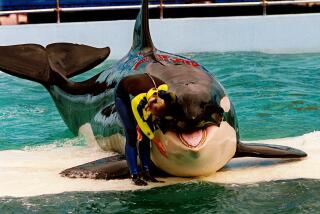‘In the Water, They Are the Masters and You Are the Pets’ : Humans Pay to Swim and Frolic for Amusement of Dolphins
KEY LARGO, Fla. — Four times a day, the Borguss family allows groups of humans into their saltwater canal to swim with their pet dolphins. It is for the amusement of the dolphins, not the humans.
But the humans are apt to get the ride of their lives.
For $25 they can swim and frolic with four of the family’s eight dolphins for 30 minutes. Mask and fin rental is extra.
The family is fond of telling swimmers that they are fresh toys, brought in daily to amuse the animals.
“Here, you are the toy, the puppy trying to please the dolphin. In the water, they are the masters and you are the pets,” said Lloyd Borguss.
If the dolphins are in a good mood, and they almost always are, they will tip their dorsal fins toward the swimmers, wait for them to grab hold, and take off--racing across the canal with the swimmers in tow.
‘It’s a Blast’
Often, two dolphins will approach, allow the swimmer to grip onto both, and race away in unison, occasionally diving below the surface. The giggling swimmer, aloft between the two animals, must let go or gulp for air and hold his breath until the animals surface.
“It’s a blast. You just have to experience it,” said Tyler Britt, a children’s librarian from Roan Mountain, Tenn., vacationing in Key Largo with her husband and daughter. “I can tell a story the kids would not believe.”
The dolphins live in a fenced-off part of a 12-foot deep canal that flows between the Atlantic Ocean and Rock Harbor. The tide’s cleansing action flushes away bacteria that could cause problems in an enclosed tank and helps keep the animals from catching colds from their human “pets.”
If the dolphins are in a bad mood or tire of their human company, they can swim into a fenced area where humans are forbidden. They rarely seek refuge there, and never for very long.
Perpetual Impish Smile
The Borgusses’ dolphins are Atlantic bottlenose dolphins, the Flipper type. Teen-agers by dolphin standards, they are 8 feet long and weigh 350 pounds. The males will grow to weigh up to 500 pounds. Despite their enormous size, they are extraordinarily playful and their large, curved mouths give them a perpetual impish smile.
The family, Lloyd and Ann Marie Borguss and their son and his wife, Rick and Brigetta Borguss, operate the Dolphins Plus Inc. Marine Mammal Training Center.
Brigetta Borguss had wanted to own dolphins since she was a teen-ager cleaning pools and cutting fish for a marine show in her native Switzerland.
“But in Europe you can’t just go out and catch a dolphin,” she said.
After moving to Florida, she and her husband obtained the necessary state and federal permits, and trapped the dolphins at Charlotte Harbor near Fort Myers on Florida’s Gulf Coast. A veterinarian visits twice a month, and the Marine Patrol makes surprise visits to ensure that the dolphins are well treated.
Recruited Swimmers
The Borgusses began recruiting people to swim with the dolphins as part of a research program, asking swimmers to fill out detailed questionnaires afterward.
“At first, it never dawned on us that we could charge for it,” Lloyd Borguss said. “Then we started getting so many people, they would hang all over the fence asking if they could swim with our dolphins.”
Dr. Betsy Smith, a professor at Florida International University, collects the questionnaires for her research on the bond between humans and animals. She has brought autistic children to swim with the dolphins, successfully using the playful animals to draw the children out of their own private world.
Swimmers are referred through five Key Largo dive shops and must be at least 12 years old, although exceptions are regularly made for young children swimming with their parents.
Before turning them loose in the water, the family briefs swimmers on dolphin behavior.
“It may swim right up and poke you with its snout. When it leans into you like that, it’s checking you out,” Lloyd Borguss tells the group.
Detect Fetal Heartbeat
Pregnant women are warned that they will probably be “adopted” by the two female dolphins, who may push other swimmers away from them. The animals are adept at detecting pregnancy because they can hear the fetal heartbeat with the sensitive sonar system in their lower jaws.
When dolphins give birth in the wild, one of the females acts as a midwife, regularly pushing the newborn dolphin to the surface to breathe until the mother has recuperated enough to take over.
“That strong maternal instinct makes them very possessive with a pregnant woman out there,” Lloyd Borguss said.
The Borguss family once played a trick on the animals, bringing in a woman who was pregnant with twins.
“The dolphins couldn’t figure it out. They kept rubbing their snouts on her belly. One extra heartbeat they could accept, but they couldn’t account for three. They don’t have multiple births,” Lloyd Borguss said.
Similar Puzzlement
A swimmer with a pacemaker elicited similar puzzlement.
Giving humans rides is not instinctive dolphin behavior, but most that are around humans acquire the habit, Brigetta Borguss said.
“They just pick it up. Once you gain their trust, it’s a natural thing for you to touch them and hold onto them. If you hold their fins and they take off, you get a ride. Once they realize that makes you happy, then they do it all the time,” Brigetta Borguss said.
It is not unusual for the dolphins to blatantly prefer a particular swimmer or to shun another, especially if the swimmer has an aggressive personality. To ensure that everyone gets a ride, the dolphins are rewarded with sardines when they tow swimmers to the dock.
Those who find favor with the animals will get rides even after the sardines are gone. That leaves the humans trying to curry favor with the dolphins. Uneasiness with the role reversal of master and pet is a common reaction among the swimmers, according to Smith’s research.
Dolphins Converse
The dolphins chirp and make clicking sounds, sometimes diving to the bottom of the water in groups to converse in a code no human has been able to break. That leaves the swimmers feeling a little left out, wondering if the dolphins are talking about them and what they are saying.
Most swimmers are also surprised at how gentle the dolphins are, how soft and smooth their skin is--wet suede is the most common comparison--and how warm they are.
“They’re not slimy or icky like a fish,” Lloyd Borguss said. “Most people know that they are mammals, but they don’t expect their body temperatures to be the same as their own.”
The animals do not bite, but occasionally nuzzle swimmers’ legs with their small teeth, a sign of dolphin affection.
“He’s kissing you. He’s giving you a hickey,” Borguss tells a startled swimmer whose leg is caressed by harmless dolphin teeth.
Compared to Puppies
Britt’s husband, Dan Theele, a veterinarian, compared the dolphins to horses in size and to puppies in demeanor.
“They’re very powerful, but there’s a gentleness about them. They really respond to your attention. When you rub their bellies, they roll over and swim on their backs.”
After swimming with the dolphins, people have more respect for marine life, Brigetta Borguss said.
“Hopefully, the people who come here will think twice about throwing a can in the ocean,” she said.
“So far, we’ve got the dolphins conned into believing that all people are nice,” Lloyd Borguss said. “If they ever learn the truth, we’re in trouble.”
More to Read
Sign up for Essential California
The most important California stories and recommendations in your inbox every morning.
You may occasionally receive promotional content from the Los Angeles Times.










